Shin Megami Tensei IV Review

The statue of the great Aquila beckons, “Come at me, bro.”
Nutrition Facts
Genre: RPG
Mode: Single-player (with online components)
Rating: M for Masochistic… I mean, Mature. (But seriously, yes, masochistic.)
Developer: Atlus
Publisher: Atlus / Nintendo (Korea Only)
Composers: Ryota Koduka, Kenichi Tsuchiya, and Toshiki Konishi
Platform: Nintendo 3DS
Release Dates: May 23, 2013 (Japan); July 16, 2013 (North America); Q2/Q3 2013 (Europe… lol, good luck with that)
—
Preface
Before we begin, if you only want to know if this game is worth buying, let me just say, “Yes. Unequivocally, yes.” This game is absolutely incredible and worth every penny of the price of admission. It’s the real deal–the true successor in the Shin Megami Tensei series, also known as 真女神転生 in Japanese. (TL Note: 真女神転生 means Shin Megami Tensei.)
I’ll admit, I wasn’t convinced when I started playing the game. I thought it was just a slightly better version of Shin Megami Tensei: Devil Summoner: Soul Hackers for a time. But then I realized my journey through SMTIV paralleled the young Samurai. I was just like the Casualry Flynn, the protagonist who had been thrust into an unfamiliar situation and unreasonably asked to quickly adapt. Of course nothing would make sense initially. Like Flynn, I had never been inside Mikado Castle, Naraku, or “New” Tokyo. In my time playing, the game only got better and better.
If aren’t convinced, if you aren’t a fan of the SMT series (main or not), or if you haven’t played many (or any) of the SMT games, read on and see what SMTIV has to offer you. Know, however, that there will be minor spoilers of the first few hours of the game (out of 35+ hours).
—
The Writing
As far as I know, the story of SMTIV is completely unrelated to the other SMT games, so you don’t have to worry about playing any of the other games in the series.
In the Eastern Kingdom of Mikado, the Samurai are an elite force of peacekeepers. Every year, they hold a Gauntlet Rite to see if any Gauntlets will accept new members into the order. Five were chosen this year: Walter, Jonathan, Isabeau, Navarre, and Flynn (default name for the protagonist).
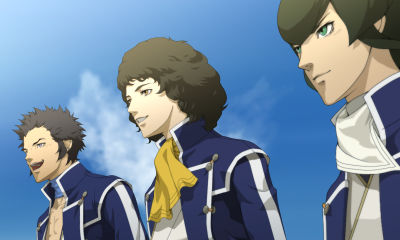

Walter, Jonathan, Flynn, Flynn in surprised mode, and Isabeau.
Walter, a Casualry or working class, is glad to become a Samurai if it means he doesn’t have to continue his family’s business. He finds the job fun, but he takes it very seriously as well. He prefers action and believes that “might makes right.”
Jonathan is his polar opposite. He was born into the upper class called the Luxurors, he’s very considerate of others, and he wants to protect the peace, but he, too, is steadfast in his convictions and duties as a Samurai.
Isabeau is also a Luxuror and the only new female Samurai this year. She’s the hardest to get a read on. She’s serious at times and moeblob at others, but when the time comes, she, too, will show what it means to be a Samurai.
Finally, there’s Flynn. His characterization is up to you, the player. You will be confused about where to go in New Tokyo, how to navigate the field, how to initiate combat, and what to do because Flynn himself would probably be as confused as you are. Flynn only knows as much as you know. Self-inserts are usually hated, but it works very well here.


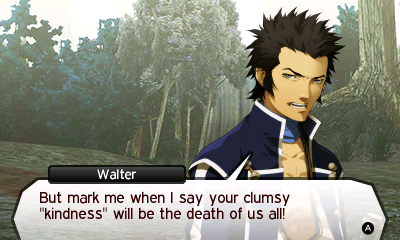

People saying things.
Characterization for the others is done primarily through mostly voiced dialogue, some text-only dialogue, and implied actions. Character portraits change expressions and shift in and out of view to match who’s talking. Like a visual novel, don’t expect any lip syncing or characters acting things out here. Even so, it didn’t take long for me to become fully immersed in the world and characters.
As for the actual plot, the first act involves the young Samurai prentices learning the true purpose of the Samurai: to eliminate demons in Naraku, the dungeon below Mikado Castle. It isn’t long before they receive news of a Black Samurai giving people a new kind of book called “Literature” that turns people to demons after prolonged exposure. (Symbolism!) Knowledge and wisdom, they say, are dangerous. (Foreshadowing!)
The Black Samurai beckons the young prentices to come to “the underground,” where they might gain knowledge and wisdom. So begins their true journey to the underground… to Tokyo. This Tokyo isn’t the one you and I know, though. It’s completely rundown and infested with demons. The only thing keeping the place from falling into utter chaos is the Ashura-kai, but the Ring of Gaea isn’t making it easy for them. Then there are the Hunters, who aren’t nearly as cohesive.
The young prentices are tasked with going there to capture the Black Samurai in the name of their Lord. At the same time, they will learn more about the shared history between Tokyo and the Eastern Kingdom of Mikado and the various factions.
The plot is a little sparse for the first few hours of the game, but it snowballs quickly. What I described barely scratches the surface of what SMTIV offers. You learn more about the mysterious setting, the characters, the factions. You don’t get everything, or the magic disappears, but trust me. The endings and the writing in general are incredibly satisfying. I’d recommend SMTIV to anyone based on the writing alone.
—
The Sounds
Listen to the title screen music. (It’s the same one from all the trailers.) Just sit there and listen before you start your first game. It is fucking amazing.
The music maintains a good balance between ye olde bagpipes and tribal-like for the Eastern Kingdom of Mikado. Each district in Tokyo has its own underground city theme that speaks to the environment within the city. Those pieces are typically upbeat electronica. The exploration themes are more mystical and add to the tension of exploring a broken world.
The voicework is also good in my opinion, as expected of an Atlus USA dub. As the first game in the main series to feature extensive (or any?) voice acting, it does so successfully.
—
The Visuals
The Eastern Kingdom of Mikado is massive, so it’s only represented by static renditions of the space, but the dungeons and locations in Tokyo are fully explorable in 3D. They honestly look great. I am, however, disappointed in the Demon’s Domains. Re-skins would’ve been better than reusing the same texture and color pallette over and over again.
And sadly, the character sprites that occasionally pop up are barely more detailed than the ones we got in Soul Hackers. Although SMTIV has emotive character portraits and good voice acting, it isn’t quite the same as seeing 3D sprites reacting to things. It’s why P3P, as amazing as it was, didn’t quite eclipse the original. Some of the maps are quite large, so I don’t know why they couldn’t render a smaller space for in-game cinematics to accommodate 3D sprites.
Sprites in battle are barely better. You also can’t see Flynn or his demons attacking, only their spell animations.
Overall, though, the art direction in SMTIV is fantastic. Everything is a cohesive package with nothing feeling out of place. Seriously, the 14th century-style keeps, the cityspace of Tokyo, and fantasy-sci-fi elements work together to create a truly interesting world that’s just begging to be explored.
—
The Gameplay
Most of your time will be spent (spoilers) playing the game, primarily exploring Mikado and Tokyo. Like I said before, Mikado is navigated via menus, whereas Tokyo has an overworld map with access points for more detailed dungeons, districts, etc. You’ll be following Flynn in third-person, either zoomed out or over the shadow. You can look up or down to go up stairs, go through manholes, and so on. It’s quite an improvement over first-person dungeons.
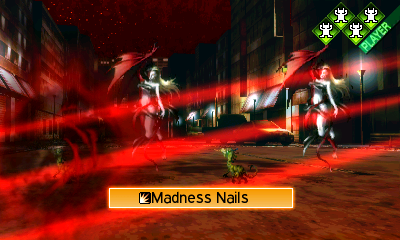
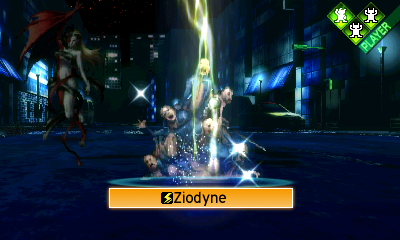

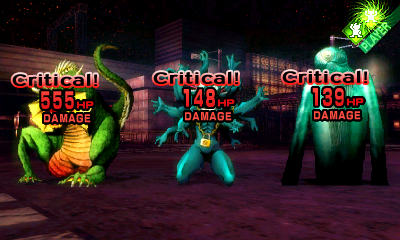
Flynn, his demons, and battle options are on the bottom screen.
The battle system is definitely a step above Soul Hackers. It’s very strategic in how you want to handle the flow of battle. You can exploit enemy weaknesses for extra turns in battle, debuff with extra turns, and go back to exploiting weaknesses to gain more turns. You can get up to eight turns in one battle phase. But be careful, for enemies have these advantages, too. You also lose one turn if you miss an attack or all your turns if an enemy blocks/reflects an attack. Luckily, your enemies face the same penalty.
Though not quite as fluid as Persona 4 Golden, the battles here are fast and tactical, but not much skill is required. Exploration is what checks your skill and attentiveness. On your first playthrough, you can’t be lazy. At all. At least not until the 30-hour mark. Doing so spells certain death 90% of the time. You need to be quick to strike your enemies to engage in battle. Sometimes, demons will appear out of thin air, and you must react quickly or face an enemy advantage.
The game is very unforgiving about this. If the enemy gets an advantage, you’re either severely crippled or killed before it’s even your turn. If it’s any consolation, you can actually sit through a little cinematic and pay to be revived. Do that twice and you’ll gain access to two easier modes. (Note: I’ve only heard this but haven’t confirmed it myself. I just restart the game if I ever die.) Once Burroughs, the Gauntlet’s navigational AI, reveals herself to you, you can basically save whenever you want outside of battle. I personally saved after every other battle if not more because I’m super paranoid. You better do so too because you are going to die. A lot.
It’s brutal and frustrating as all hell, but that makes for a better gaming experience. As soon as I step outside of a safe zone, there’s instant tension that my next battle could very well kill my party. Even with anywhere saving, I still felt that tension; it’s possible to enter unwinnable situations if you don’t use your two save slots wisely. Like me, you’ll probably drop your guard, take things easy, stop saving after every other battle, but that’s when the game gets you. Naraku and Tokyo are unforgiving places, so a true Samurai must remain vigilant. Outside of one douchebag boss who uses mother-fuckin’ Mamudoon, most deaths will be preventable. They require the player to be attentive and prepared with the right gear and demons.


That brings me to the major improvement SMTIV has over all of its predecessors: integration of demons and gameplay. When you level up a demon, it gains new skills, and when it learns its final skill, it can teach any active abilities to Flynn or upgrade existing spells. When fusing demons, the product demon can inherit any of its parents skills. Combine these features with the in-game Apps you can buy to lower demon spell costs, add demon spell slots, lower demon buyback costs, extra stats after leveling, and so on. It completely fixes the problems with demons in Soul Hackers and Personas in Persona 4 Golden. That is, it isn’t a bitch to get the skills you want, and you can’t beat the entire game with one Persona.
Burroughs Apps can also support Flynn by giving him more spell slots, auto-pinpointing known weaknesses during battle (by pressing L), etc. Unlike Soul Hackers, you can actually build Flynn any way you want. It takes awhile to get a piercing-type weapon, but it’s perfectly viable to go a physical or magic build, since even physical abilities use MP, not HP. I personally went with pure magic to exploit elemental weaknesses. Very few bosses aren’t weak to a specific element.
A quick word about length–beating the game took me about 37 hours while doing plenty of side quests. Tokyo’s a confusing place, and I spent many, many hours wandering around.
It may be premature of me to mention this, but after you beat the game, you are given two options for New Game+. You can elect to start over at level 1 or keep your current level, stats, and money. Regardless, you keep certain Apps (maybe App Points too), Demon Compendium, unlocked Special Fusions, and probably a few other things I’ve forgotten by now. Basically, you can choose a fresh start to try out a new play style (magic versus physical) or keep your character to quickly experience different routes/endings.
I’ll end with a quote from the teaser trailer: “The choices you make will no longer bear on you. What you do will create a world.” Keep those words in mind as you play. I was asked many things along my journey. I thought my choices had no effect on the world at first, but all was revealed in time. My actions were ultimately reflected in the world I created.
—
TL;DR Version
What I liked:
– Fantastic writing. It’s reason enough to play this game.
– GRIMDARK and DEEP themes with ambiguous concepts of morality and ethics.
– Satisfying and widely divergent conclusions.
– Atmospheric music.
– Fun and varied game mechanics.
– Well thought out demon component.
– New Game+ choices.
– Brutal
What I didn’t like:
– Two save slots? Really?
– Human sprites are lackluster.
– No ally sprites during battle. :(
– No “remember” option for battle.
Overall Score: 9 out of 10 (Great). A must-have for any RPG lover.
Addendum (July 13, 2013): 20 hours later. YOOOOOOOOOOOOO. That neutral ending. Buy this game.
Posted by brainchild under 3DS, Video Game Reviews | Permalink
They should just make a new Jack Bros. game instead of another Mr. Tall, Dark and Deep SMT.
Hee-ho.
EU release when?
fuck yeah ziodyne
I was on the fence about this game but you really make it sound like a worthwhile purchase. Going to push up my priorities on this one.
I second that. Waiting for this (doubtlessly) awesome game is suffering. D:
The 2 Save Slots thing is probably a carry-over from the 2 Super Famicom / SNES games.
Man, July 16 cannot come soon enough.
I get why Atlus wanted limited saves, but it’s still easily circumvented by the 3DS supporting save backups and restorations.
Doesn’t that only work for digitally downloaded games though?
Anyway, how’d you get the game already? Or did you play the Japanese version?
Why do you think he’s reviewing it? Not for fun.
You guys DON’T do these just for fun!? mind = blown
Companies give us games. And they like it.
I have not played many SMTs, but I liked SMT: Strange Journey pretty much.
Do you say this SMT has a similar style?
I like what I see, I think I will buy it whenever they release in Europe.
> SMTIV
> Brutal
What? More like almost Persona-tier casual.
I’m playing Digital Devil Saga to fill in a gap in my soul currently… I wish I had a 3DS :(
DDS is good except for the ludicrously high encounter rate.
i won’t recommend buying any nintendo console, especially only to play a few games. I bought a 3ds and now i’m very sorry.